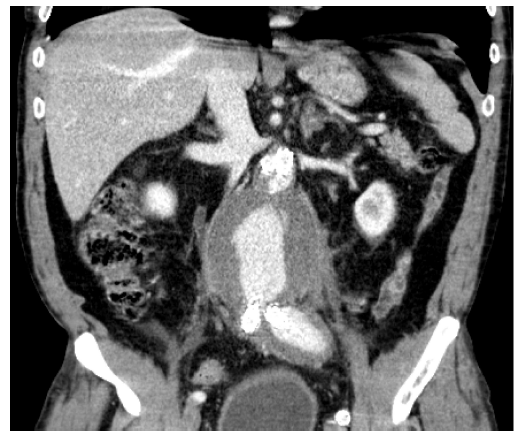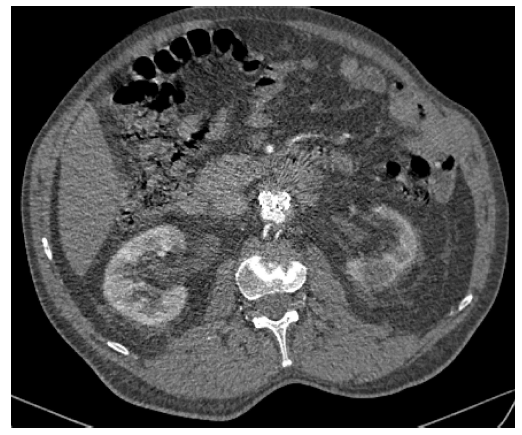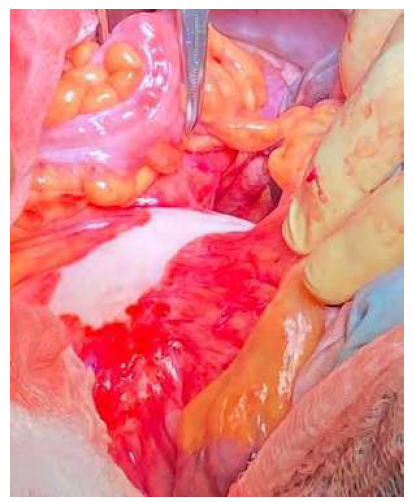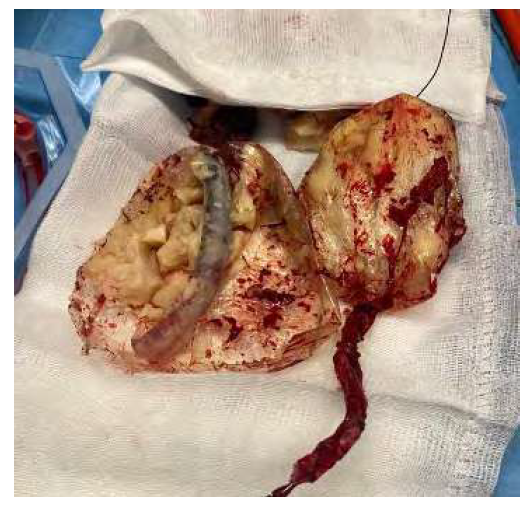Introduction
EVAR has become a very appealing mode of treatment of infra-renal abdominal aortic aneurysms (AAAs).1 In the last decades, manufacturers developed newer stent grafts and delivery systems to allow better suitability so that more aneurysms could be included in the instructions for use with fewer associated complications.
A large review, recently published, found that the overall incidence of late conversion is very low, with an estimate incidence rounding 1.9% (range, 0.4%-22%).2
Nevertheless, considering one specific device named Nellix (Endologix, Irvine, Calif, USA) based on the concept endovascular aneurysm sealing with endobags (EVAS), the manufacturer recently issued a hazard alert due to high rates of endoleaks, migration and aneurysm enlargement. The authors present a case of type 1a endoleak following EVAS, managed successfully with total graft explant and in-situ reconstruction.
Case report
A seventy-year-old male was referred to the vascular outpatient clinic of our institution.
In 2017, in Germany, he was submitted to endovascular correction of an abdominal aortic aneurysm. One year later, a secondary intervention took place, again in Germany, for which there was no further information. He then moved to Portugal, and it was not possible (despite contacts) to access the previous imaging studies conducted before the EVAR, the procedure records nor the follow up protocol or patient data. Therefore, the authors could not explain why the Nellix procedure was the choice in the first place.
The patient had a prior history of ischemic stroke in 2014, hypertension, diabetes, dyslipidaemia, and smoking habits. A computed tomography angiography (CTA) was performed, revealing an abdominal aortic aneurysm with a maximum diameter of 101mm (Figure 1) with endovascular material compatible with a Nellix endoprosthesis complicated with a type Ia endoleak (Figure 2) associated with a left common iliac aneurysm with endoluminal material resembling coils. The endoprosthesis extended to the common iliac artery on the right side and to the external iliac artery on the left side.

Figure 1 Pre-operative computed tomography angiography - coronal plane. Abdominal aortic aneurysm with a maximum diameter of 101mm

Figure 2 Pre-operative computed tomography angiography - axial plane. EVAS endoprothesis complicated with a type Ia endoleak
After cardiac and respiratory workup and multidisciplinary discussion including the ansthesiologists, the patient was proposed for endoprosthesis explantation and conversion to open repair.
Intraoperatively, we noticed significant adhesion of intestinal structures to the aneurysm resembling an inflammatory process (Figure 3) and periaortic dissection was found impossible due to absence of cleavage planes. We firstly tried to dissect between the left renal artery and the aneurysm sac with no success. Consequently, we obtained control at the para-renal aorta for proximal clamping. Distally, we faced the same difficulties at the common iliac arteries, so we isolated at the more distal external iliac arteries.
Significant adhesion of intestinal structures to the aneurysm resembling an inflammatory process
Due to the above-mentioned difficulties and since the proximal infrarenal neck was aneurysmatic, the proximal infrarenal aorta was resected and proximal anastomosis was performed close to the left renal artery, in an end-to-end fashion. Due to adhesion process also at the iliac level, distal anastomosis was performed at the external iliac artery, bilaterally, with end-to-end anastomosis at the left side and end-to-side at the right side, to provide retrograde flow to the internal iliac artery.
Once the revascularization was completed, the aneurysm sac was opened. Endobags as well as the endoprosthesis were explanted (Figure 4) and common iliac artery ostia ligated.
The procedure took six hours and after 48 hours of admission at the intensive care unit, the patient was discharged at the fifth postoperative day with an uneventful recovery.
At 6 months of follow-up there were no events. A new CTA was performed at one month post-operatively, revealing graft patency and total aneurysm exclusion.
Discussion
The Nellix endovascular aneurysm sealing system was presented as a novel concept in the treatment of abdominal aortic aneurysm. After numerous adverse events, the manufacturer voluntarily withdrew the device from the market.
The Nellix EVAS system consists of balloon-expandable stents surrounded by endobags filled with polymer, which seal the aneurysm. While EVAR devices mainly rely on graft apposition on the proximal and distal sealing zones, EVAS addresses the principle of complete anatomic apposition to the aneurysmatic sac to achieve sealing and try to mitigate the risk of complications and secondary interventions.
Nevertheless, in the absence of a proximal fixation mechanism in EVAS, once eventual migration of the Nellix system occurs, it further complicates with a persistent type I endoleak resulting in continued aneurysm growth and inferior dislocation of the stents within the aneurysm sac. Proximal migration of the Nellix endoprosthesis has been reported to occur in 17 % of cases.4
In 2019, the European Society of Vascular Surgery3 published guidelines for abdominal aortic aneurysms where new techniques/concepts (such as endovascular aneurysm sealing with endobags) were not recommended in clinical practice and should only be used with caution, preferably within the framework of studies approved by research ethics committees, until adequately evaluated.
Unfortunately, many cases were already performed all over the world and it is paramount that now, clinicians must have skills to deal with eventual complications.
Once presented with a type I endoleak, treatment should be offered promptly, with the aim to exclude the aneurysm from pressurized circulation.
Endovascular options to treat proximal type I endoleaks following EVAS are very scarce. Transcatheter embolization using Onyx with or without coils has been described as a feasible and effective method.5 Complex EVAR, extending the landing zone with proximal tubular or fenestrated cuff insertion could be another option.
In our case, we decided upon an open surgical conversion as it seemed a more definitive solution and the patient had a good operative risk.
Scali et al published results demonstrating that elective conversion for type 1a endoleak after EVAR might be performed with similar rates of morbidity and mortality when compared to primary open juxtarenal aneurysm repair in appropriately selected patients.6
Although historical series have documented a mortality rate up to a 22% with OSC, modern series have documented elective mortality rates even bellow from 3.3-10%.7,8
When comparing the results between OSC and endovascular correction procedures, the authors believe the results would potentially bias the outcomes in favor of the open surgery cohort group if the comparison control group used was the suprarenal and/or thoracoabdominal endovascular aortic repair.
Considering the morphology of our case (juxtarenal fusiform aneurysm with extensive thrombus in the proximal neck), we believe that there might have been a type I endoleak development with later proximal neck aneurysmatic degeneration and subsequent eventual endoprosthesis migration. Fenestrated or branched endovascular aortic aneurysm repair would be technically very demanding, due to anatomical restrains and need for extensive aortic coverage. In the absence of other straightforward endovascular options, such as an infra-renal cuff placement, we generally would not consider other options such as endo-stapling or embolization, if appropriated.
Considering the abovementioned, we believe that in patients, deemed to be fit for open conversion after pre-operative risk assessment and multidisciplinary discussion, and in particular those with challenging morphology for endovascular options, open conversion may constitute a very acceptable method of repair and should be offered.

















